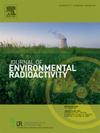A new methodology for the evaluation of radon diffusion coefficients in anti-radon membranes
IF 2.1
3区 环境科学与生态学
Q3 ENVIRONMENTAL SCIENCES
引用次数: 0
Abstract
Indoor radon is classified as a carcinogen because it can lead to lung cancer. Some radon preventive strategies are related to building protection with radon barrier materials whose capacity to stop the gas depends on the diffusion coefficient, which can be calculated using different techniques. In this article, we propose a new experimental device, called TESTMAT, to measure the radon diffusion coefficient, using a weak radon source, to prevent radiation protection oversight. The device is small and made from PVC. The sample of the tested material is placed between the source and the receiver containers, as indicated by ISO/TS 11665-13 standard. Since a non-stationary radon diffusion occurs in the system, we developed a specific software, ENDORSE, to model radon activity concentrations in the receiver chamber and the diffusion through the material by applying the explicit finite difference method. The software utilizes Montecarlo simulation to determine the error associated with the diffusion coefficient. Different tests were performed to calibrate the system and assess the value and the evolution of background radon during the two-week measurement. When working with low-activity radon sources, this parameter cannot be neglected, particularly with the best performing membranes. An adequate sample holder was selected to guarantee a good airtightness, with a leakage constant of only 7 % of the radon decay constant. The minimum detection limits were calculated based on the material thickness and the source intensity. The system was finally tested with three commercially available waterproofing membranes and results compared with expected values, based on literature.
一种评估防氡膜中氡扩散系数的新方法
室内氡被列为致癌物,因为它可以导致肺癌。一些氡预防策略与氡屏障材料的建筑保护有关,其阻止气体的能力取决于扩散系数,可以使用不同的技术来计算。在本文中,我们提出了一种新的实验装置,称为TESTMAT,用于测量氡扩散系数,使用弱氡源,以防止辐射防护监督。该装置很小,由聚氯乙烯制成。按照ISO/TS 11665-13标准,被测材料的样品放置在源容器和接收容器之间。由于系统中发生了非平稳的氡扩散,我们开发了一个特定的软件,通过应用显式有限差分法来模拟接收室中的氡活度浓度和通过材料的扩散。该软件利用蒙特卡罗模拟来确定与扩散系数相关的误差。在为期两周的测量期间,进行了不同的测试来校准系统并评估本底氡的值和演变。当使用低活度氡源时,这个参数不能被忽略,特别是使用性能最好的膜时。选择一个适当的样品支架以保证良好的密封性,泄漏常数仅为氡衰变常数的7%。根据材料厚度和源强度计算出最小检出限。最后对该系统进行了三种市售防水膜的测试,并根据文献将结果与期望值进行了比较。
本文章由计算机程序翻译,如有差异,请以英文原文为准。
求助全文
约1分钟内获得全文
求助全文
来源期刊

Journal of environmental radioactivity
环境科学-环境科学
CiteScore
4.70
自引率
13.00%
发文量
209
审稿时长
73 days
期刊介绍:
The Journal of Environmental Radioactivity provides a coherent international forum for publication of original research or review papers on any aspect of the occurrence of radioactivity in natural systems.
Relevant subject areas range from applications of environmental radionuclides as mechanistic or timescale tracers of natural processes to assessments of the radioecological or radiological effects of ambient radioactivity. Papers deal with naturally occurring nuclides or with those created and released by man through nuclear weapons manufacture and testing, energy production, fuel-cycle technology, etc. Reports on radioactivity in the oceans, sediments, rivers, lakes, groundwaters, soils, atmosphere and all divisions of the biosphere are welcomed, but these should not simply be of a monitoring nature unless the data are particularly innovative.
 求助内容:
求助内容: 应助结果提醒方式:
应助结果提醒方式:


